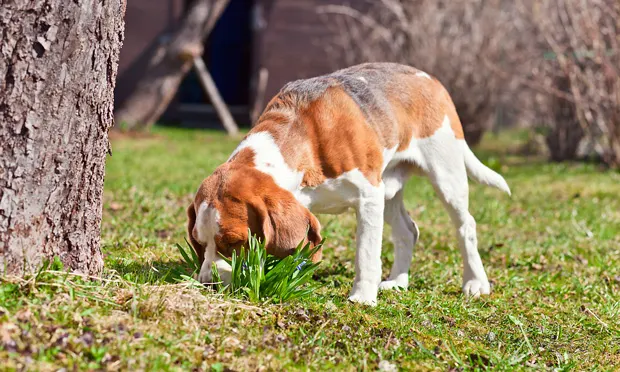Coprophagia

Consequences of eating fecal matter include gastrointestinal (GI) upset, intestinal parasitic infection, the transmission of infectious disease and medication toxicity.
Coprophagia, the consuming of fecal matter, is a frequent complaint by dog owners. Consequences include gastrointestinal (GI) upset,1 intestinal parasitic infection,2 transmission of infectious disease, medication toxicity,3,4 and owner disgust.
Generally, coprophagia is a normal behavior in nursing bitches in order to keep the den clean5 and briefly in puppies, presumably to help establish gut flora.6 Coprophagia has also been associated with attention-seeking behavior,7 lack of stimulation/enrichment, learned behavior from other dogs in the household, self-reinforcing behavior (presumed attractive smell/taste),7 hunger, play,7 environmental stress,5 and anxiety. Dogs acquired from pet stores are more likely to exhibit this behavior as compared with puppies from breeders.8 Although experimentally induced thiamine deficiency has been linked to coprophagia,9 dogs being fed commercial dog foods are typically on a well-balanced diet, making dietary deficiency low on the list of differentials.
At a minimum, physical and fecal examinations should be performed on dogs presenting with coprophagia.7,10 Because chronic pancreatic insufficiency,2,7 malabsorption,11 and starvation have been linked to coprophagia,12 pancreatic and GI function tests should be performed when GI involvement is suspected.
A thorough history should include diet,1 acquisition (eg, pet store, breeder), progression, frequency, owner presence during the behavior, source of animal feces being consumed (eg, wild animal, another dog in the household), health of other animals in the household,1 and location of consumption (eg, backyard, on walks). General information regarding other pets in the environment should also be obtained because in some cases, the feces being consumed may be from a particular pet. It is hypothesized that there is a greater attraction toward the feces of dogs that have decreased GI transit time, likely due to undigested food in their feces.12
Although coprophagia may be common, the medical consequences are often minimal.
Treatment Measures
When catching their dog in the act, owners typically react by moving quickly toward the dog and yelling at it to stop. Often, a dog reacts by eating the feces very quickly before the owner can react. In this scenario, because the dog interprets the act of ingesting the feces as being a reward, any form of punishment (eg, yelling, pulling the dog away) can likely cause confusion and/or a fearful response.
Related Article: Baylisascaris procyonis & Raccoon Feces Ingestion
Pharmacologic & Taste Aversion Options
As noted, medical causes should always be assessed and treatment strategies instituted accordingly. For example, if the dog consuming the feces has an underlying exocrine pancreatic insufficiency,13 treating as medically appropriate for the condition can minimize the stool-eating behavior.
Various products relying on taste aversion5 to lessen the likelihood of coprophagia can be applied directly to the feces or added to the diet, depending on the specific product instructions. These types of treatments are often ineffective due to inconsistency of treatment5 and the dog’s reliance on its sense of smell for food attraction. To avoid variable reinforcement (a powerful type of reinforcement in which a response is reinforced after an unpredictable number of responses) of the coprophagia, the affected dog cannot eat untreated feces until the behavior has been extinguished.4,5 Owners must treat all dogs whose feces are being eaten. In a multidog household, this can be difficult to determine.
Behavior Strategies
In many cases, behavioral strategies can be instituted to give owners relatively quick relief, even when dogs have an underlying medical cause. The most effective behavioral treatments are (1) avoidance, (2) redirection, and (3) response substitution.6,12
Related Article: Addressing Any Behavior Problem
With avoidance, owners eliminate the offending dog’s opportunity to eat feces. For example, the dog can stay indoors or be kept on a leash5 until all other dogs in the household have defecated and the yard has been picked up. Muzzle training can also be useful in the initial stages of treatment.7,14
Redirection involves owners using a toy or treat to redirect the offending dog’s attention if, for example, they see the dog sniffing the ground in areas where feces have likely been deposited.
With response substitution, owners teach the dog an alternative behavior (eg, sitting, making eye contact) when the dog discovers fecal matter. Consistently acknowledging alternative behavior with a high-value reward can often replace the dog’s unwanted behavior. The environment should be enriched in case the dog is understimulated, paying close attention to oral enrichment devices (eg, food toys).
Summary
Although coprophagia may be common, the medical consequences are often minimal.6 However, owners can become very frustrated, thereby jeopardizing the human–animal bond. Once medical causes have been identified and/or ruled out, the most effective treatment approach focuses on owner supervision and teaching alternative behaviors.
Dr. Lisa Radosta is owner of Florida Veterinary Behavior Service in West Palm Beach, Florida. She completed a residency in behavioral medicine at University of Pennsylvania where she received two national research awards. She has authored textbook chapters, writes a column for Palm Beach Post, and podcasts CE for VetGirl. Dr. Radosta has published research papers on thyroid disease and clinician client communication and has lectured across the country and internationally. She is the behavior section editor for Small Animal Advances in Medicine and Surgery and sits on the American Animal Hospital Association Behavior Management Guidelines Task Force and the Fear Free Advisory Board.